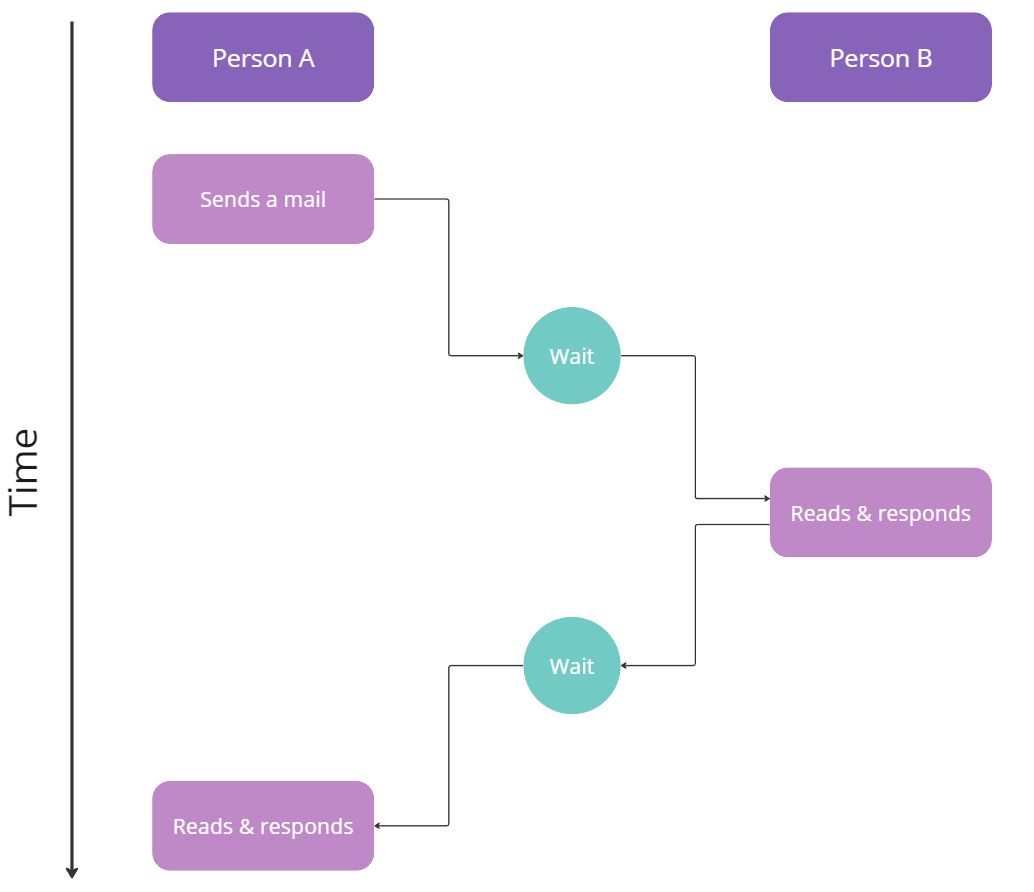In the post-pandemic world, it’s hard to imagine work without asynchronous communication. With tools like Slack or Microsoft Teams becoming increasingly common, you can work at any time, from anywhere.

However, the asynchronous work style also comes with challenges that can sometimes even outweigh the benefits. That is, unless you are smart about it and embrace the right tactics to mitigate them.
In this article, you’ll learn the basics of asynchronous communication, including its benefits and challenges, as well as best practices.
Asynchronous communication is a style of communication where participants don’t need to be simultaneously present. It usually includes wait periods in the communication process.
Let’s take mail as an example. When you send mail, you rarely get a response right away. Instead, you need to wait for the recipient to read it and write an answer, which can even take days:

Other examples of asynchronous communication include chat messages, using tickets (e.g. Jira), or even comments in GitHub.
On the other hand, synchronous communication happens in real time — an example would be a face-to-face conversation with a friend:

Both types of communication are essential in a healthy workplace, however, recently, there have been substantial shifts towards asynchronous communication as remote work and flexibility has become increasingly crucial for employees.
Asynchronous communication is excellent for many reasons, but the three most prominent ones are increasing productivity, improving employee happiness, and streamlining record keeping.
Although it’s not always so straightforward (which you’ll see in the challenges section), asynchronous communication can significantly boost productivity.
First, asynchronous communication allows people to structure their day to their natural energy cycle. Some people are more productive in the morning, whereas others prefer the afternoon or evening. With synchronous communication (e.g. meetings), there’s a high chance you’ll interrupt someone’s best hours.
Not to mention that there are always some meetings that are a complete waste of time for some participants. We’ve all been there. The more we rely on async communication, the lower the odds of that happening again.
Relying on asynchronous communication opens new possibilities.
The ability to structure one’s day is empowering. The extra flexibility people gain by not being tied to predefined synchronous events helps ensure a better work-life blend. And with a healthy company culture, even time-zone differences aren’t a problem anymore, allowing employees to travel and work from anywhere.
My favorite benefit of asynchronous communication is the built-in record-keeping mechanism.
You can always revisit past conversations for details you forgot. There’s no need to write summaries after synchronous meetings to ensure everyone is on the same page.
If you deal with annoying stakeholders who often change their minds or pass the blame on someone else, the hard paper trail of decisions made will also be quite helpful.
Asynchronous communication is not all wine and roses, though. Common challenges included message overwhelm, delayed responses, and misinterpretation.
With asynchronous communication, you can hold twenty conversations at the same time. You know what I’m talking about as a product manager.
Sometimes, you barely finish answering one chat and already have two new unread messages elsewhere.
It can easily overwhelm even the best multitaskers out there.
The wait times between answers can be problematic. It slows things down and sometimes can turn a potential three-minute-long chat into a week of back-and-forth.
If the production environment is on fire, you probably don’t want to wait until your developer finishes their deep work slot.
Without seeing the other person, it’s easier to misinterpret the message. Those small body language cues do make quite a difference.
I remember a few situations when I got mad at the other person over a chat, just to realize later that the harsh message on paper sounded utterly different in a conversation.
So, how can the challenges of asynchronous communication be mitigated while maximizing its benefits? Although everyone is different, and what works for me might not work for you, let me share some of my best practices.
Nothing is more distracting than a chat pinging you every 20 minutes that there’s a new message.
Honestly, I haven’t had my Slack notifications turned out for the last three years or so, and it’s been life-changing. Thanks to this, I am the one who decides when I want to check my communication skills
My teams know that if something is genuinely urgent and can’t wait, they can call me anytime.
With notifications off, you decide when to catch up on communication. But how do you manage FOMO to check messages every five minutes?
I usually plan out a few 15-minute slots throughout the day, during which I read through all outstanding messages and answer everything that needs my attention.
It’s the best tradeoff between having focused slots without distraction and being on top of things.
When I know the topic is somewhat complex or notice that I’m beginning to have an unproductive back-and-forth in communication, I schedule a five-minute meeting.
Let’s face it, synchronous communication will always be more collaborative and time efficient if done right. Don’t steer away from it completely.
I hate it when people overuse private channels or messages. More often than not, it leads to repeating the same messages in multiple chats and needless forwarding.
Try to focus most of your communication on open channels. You can easily avoid spam using threads, which most communication tools support nowadays. It’ll help you save time down the road.
For asynchronous communication to be efficient, you need to know how to make clear messages.
A clear message:
Spend some time editing your messages, especially if you address wider audiences. Sloppy messages lead to poor communication and misalignments.
Lastly, make sure to revisit your communication habits frequently.
I have a “communication review” as a part of my bi-weekly personal retrospectives, during which I try to figure out how to be a more efficient product manager. I look back at:
In short, treat your communication as a critical process that needs continuous improvement. It’s too important to treat it as something that just happens.
Asynchronous communication is here to stay. Moreover, I am confident it’ll become increasingly present in our daily work.
Many teams and organizations make the mistake of thinking that all they need to do is buy a license for some tools. In reality though, it’s a significant cultural change that can both double and hinder your productivity.
The challenges are real. Take them seriously, and make conscious decisions as to what asynchronous communication habits and processes work best for your context.
Featured image source: IconScout

LogRocket identifies friction points in the user experience so you can make informed decisions about product and design changes that must happen to hit your goals.
With LogRocket, you can understand the scope of the issues affecting your product and prioritize the changes that need to be made. LogRocket simplifies workflows by allowing Engineering, Product, UX, and Design teams to work from the same data as you, eliminating any confusion about what needs to be done.
Get your teams on the same page — try LogRocket today.

A practical framework for PMs to use AI in ideation without sacrificing judgment, strategy, or decision quality.

A practical five minute revenue estimation method to help product managers compare ideas, drop low impact features, and prioritize smarter.

A practical guide for PMs who want to stop being bottlenecks, delegate smarter, and lead teams effectively with a clear ownership framework.

Stop letting unreliable data block features. Treat data as inventory to track quality, ownership, and ship with confidence.